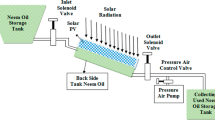Abstract
Solar cells are gaining more interest in recent times as a possible technological solution to improve energy production whilst reducing its environmental impact. The majority of the market is still dominated by first generation solar cells made of single crystal or poly-crystalline silicon solar cells. Silicon technology has reached an high standard efficiency. However, silicon technology needs a very pure material that means high cost in dollar per watt. In order to improve the production of solar power, governments have started big economical interventions, like the feed-in tariff. The advancement of technology, especially the nano-technological revolution, is bringing the attention to another generation of solar cells, hybrid/organic solar cells like Dye Solar Cells, which reduce the costs and suggest the possibility of a mass production of solar modules without the need of public funds.
Similar content being viewed by others
Notes
Schokley W, Queisser H (1961) J Appl Phys 32:510–519.
Sun S, Serdar Sariciftci N (2005) Organic photovoltaics: mechanism, materials, and devices. CRC Press.
Perlin J (2005) The story of solar cells. In: Sun S, Serdar Sariciftci N (eds) Organic photovoltaics: mechanism, materials, and devices. CRC Press, pp 5–16.
Program ‘Tetti fotovoltaici’. D. 16/03/2001 in Ministry of Environment and Territory Preservation, G.U., 29th March 2001, no. 74.
The first feed-in tariff was implemented in the US in 1978 by President Jimmy Carter.
Prospettive di sviluppo delle tecnologie rinnovabili per la produzione di energia elettrica—executive summary, GSE-Bocconi, Senato della Repubblica, Rome, 14th April 2009.
Gestore dei Servizi Elettrici—GSE Spa, the company controlled by Italian Ministry of Finance and Economy and delegated to renewable energy development.
Prospettive di sviluppo delle tecnologie rinnovabili (…), cit.
Ibidem.
Zhao J, Wang A, Yun F, Zhang G, Roche DM, Wenham SR, Green MA (1997) 20,000 PERL silicon cells for the “1996 World Solar Challenge” solar car race. Progr Photovolt 5:269–276.
Prospettive di sviluppo delle tecnologie rinnovabili per la produzione di energia elettrica (…), cit., p 14.
0.41 Euro/Kwh in Photovoltaic, compared with 0.21 in Hydroelectric, 0.14 in Aeolian, 0.07 in Oil and Methane and 0.04 in Coal Plants. APER and Universy of Padova (2007) and CESI (2004).
Prospettive di sviluppo delle tecnologie rinnovabili per la produzione di energia elettrica (…), cit.
Speakers at EPIA’s 3rd International Conference on Solar Photovoltaic Investments confirmed, in April 15th 2009, that despite the credit crunch the fundamentals of the PV sector remain intact.
Oil Price fell in 2009 under 40 dollar-per-barrel mark, in 2008 reached a maximum of 140$.
Solar Energy Report. Il sistema industriale italiano nel business dell’energia solare, AIP, Milano, 2009.
O’Regan B, Graetzel M (1991) Nature 353:737; Hagfeldt A, Graetzel M (1995) Chem Rev 95:49.
Han L, Fukui A, Fuke N, Koide N, Yamanaka R (2006) High efficiency of dye sensitized solar cell and module. In: 4th World conference on photovoltaic energy conversion (WCEP-4), Hawaii, May 2006.
Sariciftci NS, Smilowitz L, Heeger AJ, Wudl F (1992) Photoinduced electron transfer from conducting polymers onto buckminsterfullerene. Science 258:1474; Sariciftci NS, Heeger AJ (1997) Photophysics, charge separation and device applications of conjugated polymer/fullerene composites. In: Nalwa HS (ed) Handbook of organic conductive molecules and polymers, vol 1, ch 8. Wiley, Chichester, pp 413–455.
A. Di Carlo, "Fonti Rinnovabili, panoramiche e prospettive", Conference, Rome "Tor Vergata" University, November 13th 2007.
The interest in DSC development, for example, is not diffused only in the electronic and energy sector companies, but also in companies producing industrial glass and covering, and in construction.
Author information
Authors and Affiliations
Corresponding author
About this article
Cite this article
Chiappafreddo, P., Gagliardi, A. The Photovoltaic Market Facing the Challenge of Organic Solar Cells: Economic and Technical Perspectives. Transit Stud Rev 17, 346–355 (2010). https://doi.org/10.1007/s11300-010-0148-0
Received:
Accepted:
Published:
Issue Date:
DOI: https://doi.org/10.1007/s11300-010-0148-0




